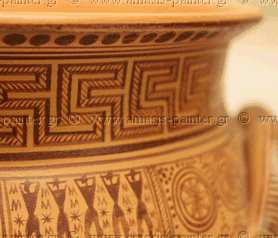Hellenic Pottery Painting
in Historical Times
|
B. Technique
The material of the ancient potter was well-sifted clay. The same material, mixed with various alkaline substances, was also used by the painter for decorative purposes. By firing the vessels, the painter was able to get the black colour for the background or for the decoration itself.
The decoration of vessels begins at the end of the 11th century BC when painters first introduced the geometric style. They divided the body of vessel into horizontal parallel zones and designed triangles, rhombs or hemicycles. The geometric style lasted for about three centuries and the various types of Greek Meander are examples of this period.
Because of the development of travel and the contact with Egypt and Cretan-Mycenaean art, a new style emerges in Corinth during the 7th century BC. The orientalizing style, which is full of depictions of animals or mythical creatures such as griffins, chimeras, sphinxes, sirens and lions. This is, in fact, the black-figure style. Figures and ornaments were painted on the body of the vessel using shapes and colours reminiscent of silhouettes. Delicate contours were incised into the paint and details could be reinforced and highlighted with colours usually red and white.
In Attica, at the same time, painters show a preference for the figural technique. They depict both silhouettes and their details with the use of the paint brush (a typical specimen of this technique is the burial amphora at the museum of Elefsis). This style is called Proto-Attic.
During the first half of the 6th century BC, black-figure style became dominant all over Attica. Attic artists, such as Exekias and Amasis, developed the style to an unparallel level of elegance, harmony and perfection. Attic painters develop further black-figure style and use it for narrative purposes, too.
At the beginning of the 5th century BC, another technique emerges, which is more effective regarding the natural depiction of the details of the human body and the three-dimensional folds of the garment. This new technique is called red-figure style because the figural depictions are in orange colour on a black background. The contours were drawn with a thin brush.
![]()
HAND MADE AND PAINTED IN GREECE






